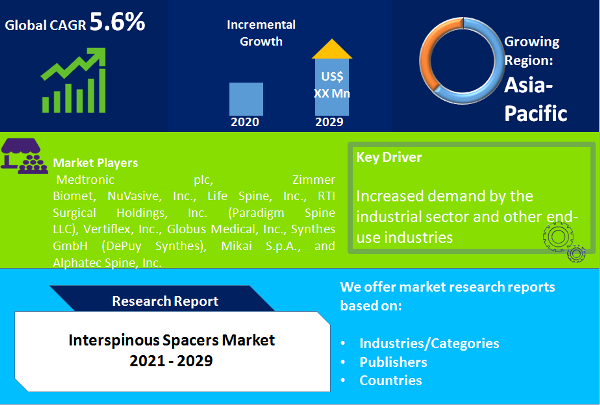Interspinous implants or spacers are proposed for stabilization or distraction of the adjacent lamina or spinous processes and arrest the extension for pain reduction in patients with lumbar spinous stenosis and other such conditions. These are small devices implanted in the spinous processes for providing dynamic stabilization as an alternative to decompressive surgery or following decompressive surgery. High prevalence of degenerative spinal conditions occurring due to aging and the offered advantages such as less risk of infection due to lower blood loss, lesser down time and motion preservation are driving the global market growth for interspinous spacers.

"Static spacers for lumbar spinal stenosis treatment to urge the market growth"
The global interspinous spacers market is segmented on the basis of product types, applications and geographical demarcation. Based on products, the static (compressible) spacers dominate the global market and shall retain its lead through the forecast period. Evidence suggest that static interspinous spacers are the most cost-effective as against laminectomy in patients with lumbar spinal stenosis. Dynamic (non-compressible) spacers segment shall be progressing at a stable rate due to better therapeutic benefits and lower failure rates.
Among the applications, lumbar spinal stenosis (LSS) is the most prominent area experiencing the largest adoption of interspinous spacers. LSS is the narrowing of the spinal canal and can either be congenital or acquired. With the consistently growing aging population, this condition is more acquired. Conventional treatment for LSS involves posture correction, muscle strengthening, and epidural injections. However, due to degenerative nature of LSS, there is a lack of complete efficacy of conventional treatments, therefore urging the need for surgical intervention. The recent introduction in surgical intervention is the interspinous stabilizers. It is clinically reported that interspinous devices offer simple and cost effective, minimally invasive alternative to standard procedures for the treatment of LSS. The latest generation of interspinous spacers also offer stand-alone functionality, therefore not requiring additional procedures for decompression.
"Asia Pacific to witness rapid growth with increasing procedure rates"
Geographically, North America is the largest regional market for interspinous spacers. High adoption rate of new technologies and earliest introduction of interspinous spacers in the U.S. market characterize the dominance of North America. Moreover, the U.S. market is also witnessing strong product pipeline with the consequent anticipation of next generation product in the region. On the other hand, Asia Pacific shall be witnessing rapid market growth during the forecast period. Rapidly evolving healthcare infrastructure, growing healthcare expenditure, improving reimbursements and skills of surgeons are the chief attributes of the fast moving Asia Pacific market. Growing geriatric populations in China, Japan and India are also urging significant market movements.
This report also includes company profiles section that gives insights on the company overview, product portfolio, financial information and key developments of major market players. The major players profiled in this report include Medtronic plc, Zimmer Biomet, NuVasive, Inc., Life Spine, Inc., RTI Surgical Holdings, Inc. (Paradigm Spine LLC), Vertiflex, Inc., Globus Medical, Inc., Synthes GmbH (DePuy Synthes), Mikai S.p.A., and Alphatec Spine, Inc.
Historical & Forecast Period
This study report represents analysis of each segment from 2023 to 2033 considering 2024 as the base year. Compounded Annual Growth Rate (CAGR) for each of the respective segments estimated for the forecast period of 2025 to 2033.
The current report comprises of quantitative market estimations for each micro market for every geographical region and qualitative market analysis such as micro and macro environment analysis, market trends, competitive intelligence, segment analysis, porters five force model, top winning strategies, top investment markets, emerging trends and technological analysis, case studies, strategic conclusions and recommendations and other key market insights.
Research Methodology
The complete research study was conducted in three phases, namely: secondary research, primary research, and expert panel review. key data point that enables the estimation of Interspinous Spacers market are as follows:
Market forecast was performed through proprietary software that analyzes various qualitative and quantitative factors. Growth rate and CAGR were estimated through intensive secondary and primary research. Data triangulation across various data points provides accuracy across various analyzed market segments in the report. Application of both top down and bottom-up approach for validation of market estimation assures logical, methodical and mathematical consistency of the quantitative data.
| ATTRIBUTE | DETAILS |
|---|---|
| Research Period | 2023-2033 |
| Base Year | 2024 |
| Forecast Period | 2025-2033 |
| Historical Year | 2023 |
| Unit | USD Million |
| Segmentation | |
Type
| |
Application
| |
|
Region Segment (2023-2033; US$ Million)
|
Key questions answered in this report